Caballero B. (ed.) Encyclopaedia of Food Science, Food Technology and Nutrition. Ten-Volume Set
Подождите немного. Документ загружается.

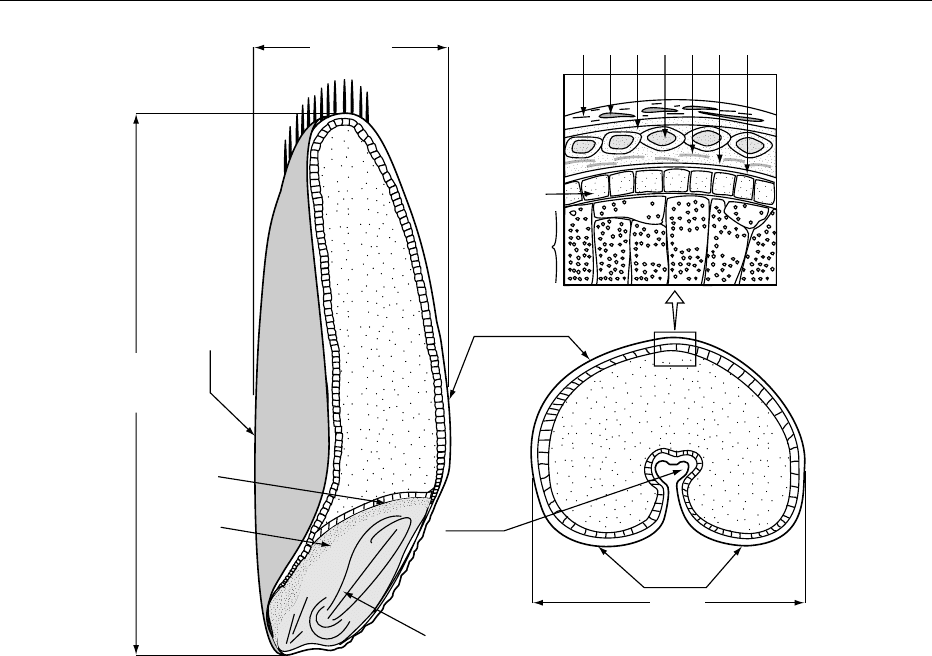
than one-third the thickness found elsewhere. The
aleurone cells are heavy-walled, essentially cube-
shaped, and free starch. The aleurone cells can vary
in thickness from 30 to 70 mm within a single kernel
and have thick (6–8 mm), double-layered cellulosic
walls.
Endosperm
0007 The starchy endosperm, excluding the aleurone layer,
is composed of three types of cells: peripheral, pris-
matic, and central. The peripheral cells are the last to
be initiated during grain filling and tend to be smaller
than the other endosperm cells (60 mm in diameter and
20–60 mm radially) and have thicker cell walls (8 mm).
Several rows of elongated prismatic cells are found
inside the peripheral cells. They extend inward to
about the center of the cheeks and are about
150–200 mm. The central cells are more irregular in
size and shape than are the other cells, and are located
inside the central endosperm. The central endosperm
cells are the first to be formed and have thinner walls
(2 mm). Cell wall thickness also appears to vary among
cultivars and between hard and soft wheat types. The
differences between hard and soft wheat may be the
result of selection: hard wheat (bread wheat) has been
selected for high water absorption. The endosperm
cell walls are composed of pentosans, other hemicel-
luloses, and beta-glucans, but not cellulose. The pen-
tosans in them absorb large amounts of water. The
endosperm cells are packed with starch granules
embedded in a protein matrix. Starch is the major
component of wheat endosperm, comprising approxi-
mately 64–75% of milled endosperm. Generally, the
starch granules in wheat are classified into two size
groups: large, lenticular (lens-shaped) A granules of
up to 40 mm across the flattened side, and small, spher-
ical B granules (2–8 mm in diameter), which are
formed later in the grain filling process.
0008In common bread wheat (Triticum aestivum) the
endosperm texture of grains varies both in texture
SE
S
EM
(a)
(b)
(c)
A
EN
EN
Length
Ventral side
Thickness
Hairs
Width
Crease
Dorsal side
Cheeks
PE
PE
PR
PR
PR
NTTCCIHE
fig0001 Figure 1 Main morphological components of a wheat kernel. (a) Longitudinal section; (b) cross-section; (c) segment of bran layer
with aleurone and endosperm cells. E, epidermis; H, hypodermis; I, inner pericarp; C, cross cells; TC, tube cells; T, testa; N, nucellar
layer; A, aleurone layer; EN, endosperm; PE, peripheral cells of endosperm; PR, prismatic cells of endosperm; SE, scutellar
epithelium; S, scutellum; EM, embryo.
WHEAT/Grain Structure of Wheat and Wheat-based Products 6139

(hardness) and appearance (vitreousness). In general,
high-protein hard grains tend to be vitreous and low-
protein soft grain tend to be opaque. Some wheat
grains are vitreous or translucent in appearance,
while others are opaque, mealy, or floury. In vitreous
kernels, with no air spaces, light is diffracted at the
air–grain interface but then travels through the grain
without being diffracted again and again. With vitre-
ous kernels, the protein shrinks but remains intact,
giving a denser kernel. As expected, the presence of
air spaces within the endosperm makes the opaque
grain less dense. The air spaces are apparently formed
during drying of the grain. If grain is harvested imma-
ture and dried by freeze-drying, it becomes entirely
opaque. This shows that the vitreous character results
during intensive drying in the field. It is also well
known that vitreous grain wetted and dried in the
field, or for that matter in the laboratory, will lose
its vitreousness. In durum wheat (T. durum), which
is much harder than the common hard bread wheats,
a much larger number of broken starch granules
occur when the grain is fractured.
Germ
0009The wheat germ is composed of two major parts,
the embryonic axis (rudimentary root and shoot)
and scutellum, which functions as a storage organ.
The scutellum is adjacent to the endosperm and con-
tains the remaining two-thirds of the grain’s thiamin
content. The germ is quite high in vitamin E (total
tocopherol) and B-vitamins, and contains many
enzymes. It is relatively high in protein (25%), sugar
(18%), oil (16% of the embryonic axis and 32% of
the scetullum are oil) and ash (5%). The sugars are
mainly sucrose and raffinose. The wheat germ com-
prises 2.5–3.5% of the kernel. Recovery of the germs
Pericarp (fruit coat)
Outer
1. Epidermis (epicarp)
2. Hypodermis
3. Remnants of thin-walled cells
Inner
4. Intermediate cells
5. Cross cells
6. Tube cells
Wheat
kernel
(caryopsis)
1. Aleurone layer
2. Starchy endosperm
1. Epithelium
2. Parenchyma
3. Provascular tissues
Seed coat (testa, spermoderm, integument)
and pigment strand
Bran
Nucellar epidermis (hyaline layer,
perisperm) and nucellar projection
Seed Endosperm
Scutellum (cotyledon)
Embryonic axis
Epiblast
Primary root, covered
by coleorhiza
Secondary lateral
rootlets
Plumule, including
coleoptile
Germ
(embryo)
fig0002 Figure 2 Parts of the wheat kernel. Reproduced from Hoseney RC (1994) Structure of Cereals. In: Principles of Cereal Science and
Te c h n ol o g y , 2nd edn. American Association of Cereal Chemists with permission.
6140 WHEAT/Grain Structure of Wheat and Wheat-based Products
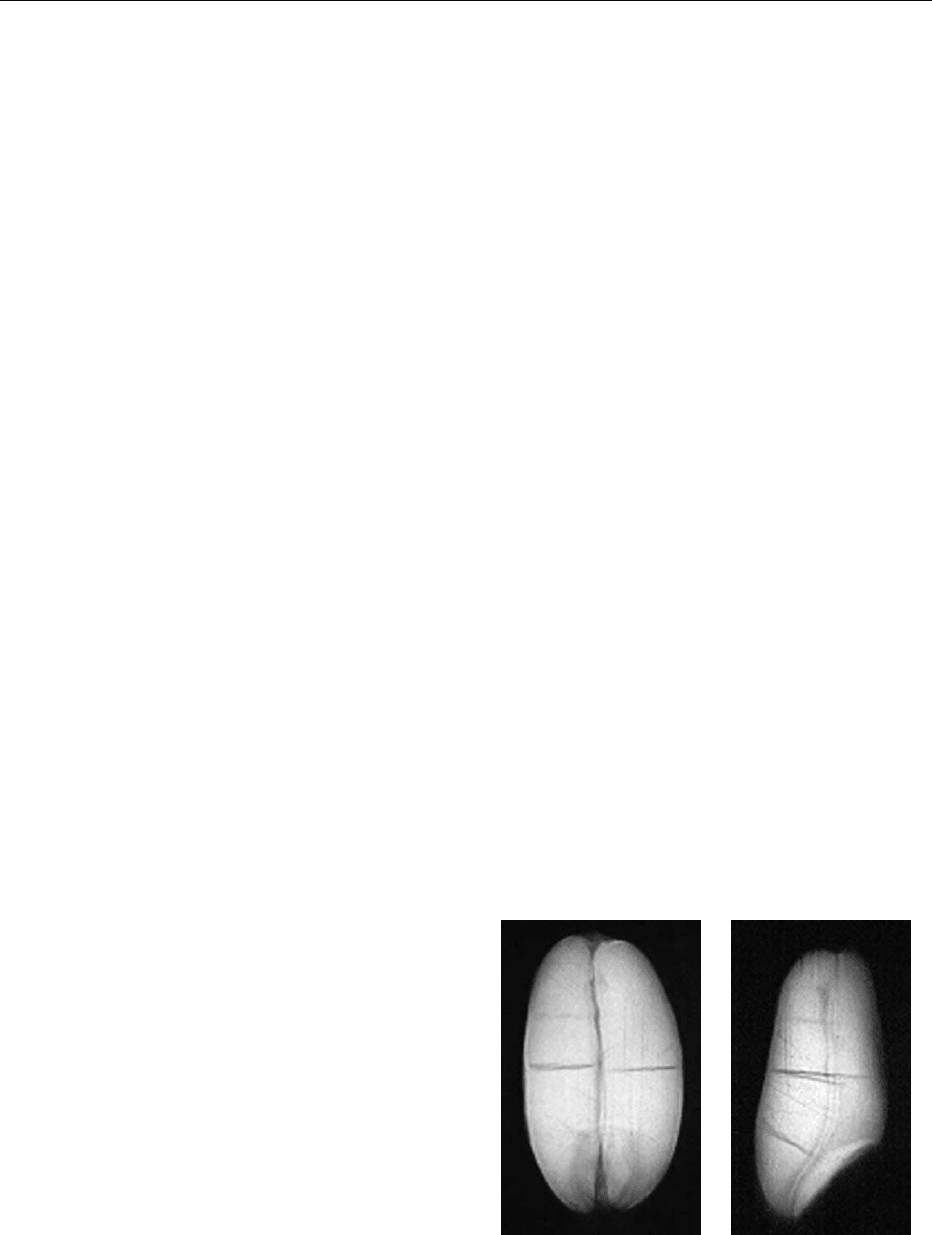
during the milling process is an important step
because of its value in the food and pharmaceutical
industries.
Techniques of Wheat Grain Structure
Study
0010 Many cereal scientists and technologists have success-
fully employed the three main branches of micro-
scopy – light (LM), scanning electron (SEM), and
transmission electron microscopy (TEM) – to study
the structure and composition of wheat and wheat-
based products. The objective of the studies varies
from gaining fundamental information on the accu-
mulation of cellular constituents in the developing
wheat grain to providing information which can im-
prove our understanding of differences in processing
ability or overall quality of wheat and wheat-based
products. Microscopic observation should always be
linked to other technological, chemical, or physical
data. This information will assist the microscopist to
select the most appropriate preparation techniques
and evaluate the nature and magnitude of any arti-
facts that may be created. In many cases a number of
microscopic techniques are used in order to gain the
maximum amount of information on the original
structure and composition of the product.
0011 LM and TEM have the advantage that many
staining techniques have been developed to assist rec-
ognition of constituents and provide data on chemical
composition. However, these techniques generally re-
quire the use of solvents during sample preparation
and these can give rise to artifacts (swelling, shrink-
ing, or leaching of soluble material). Few specific
stains are available for use in SEM, and constituents
are generally identified by their shape or location.
The advantage of SEM is that, in some cases, sample
preparation artifacts can be minimized. Recently,
X-ray techniques have been used to detect kernel
cracks (Figure 3).
Light Microscopy
0012 The main stages in the preparation of samples for
examination by LM are fixation, embedding,
sectioning, and staining. The aims of fixation are to
preserve samples from attack by enzymes or micro-
organisms, render some constituents insoluble, and
strengthen the sample to improve its structural integ-
rity during sectioning. The most commonly used
fixation is aqueous, buffered glutaraldehyde but
specialized fixation has been developed for specific
applications (e.g., fixation of lipid-rich samples).
Baked samples, which have been heat-fixed, may
not require chemical fixation. Embedding is used to
provide additional support during sectioning, and
commonly used embedding media are water and
aqueous gums for cryostat microtomy, synthetic
resins, or special waxes. Resins are generally used
where thinner sections are required and are cut
using glass knives. Cryostat microtomy and
sectioning of wax-embedded samples are carried out
using steel knives. Sections, supported on glass slides,
are then usually stained prior to mounting and
examination.
0013The stains commonly used for examination with
transmitted bright-field illumination are listed in
Table 1, together with their substrates. Fluorescence
microscopy has been widely used and may rely on
autofluorescence or the application of fluorescent
dyes. The use of fluorescent dyes coupled to specific
antibodies or lectins is rapidly expanding and several
are listed in Table 2. Other coupled antibody tech-
niques have been developed whereby colored reaction
products are produced. Polarized light can be used
to study external starch gelatinization or to provide
detail of cell wall structure.
Scanning Electron Microscopy
0014SEM has a greater depth of focus than LM and there-
fore it is not necessary to section samples prior to
examination. Samples are normally coated with a
thin layer of an electrically conducting material, usu-
ally gold, platinum, or carbon, prior to examination.
Samples of dry wheat (< 12% moisture) or similar
products only require air-drying over a desiccant
prior to coating. Samples which contain more mois-
ture, may be rapidly frozen prior to dehydration
using freeze-drying or critical-point drying. The
(a) (b)
fig0003Figure 3 X-ray images of the same wheat kernel with typical
radial cracks and transverse to the crease. (a) Front view; (b) side
view.
WHEAT/Grain Structure of Wheat and Wheat-based Products 6141

development of cold stages in SEM has obviated the
need for drying and this technique, together with
freeze-etching, has been successfully used to examine
those cereal foods in which moisture is high and
forms an integral part of the structure.
Transmission Electron Microscopy
0015 Samples for TEM require fixation and thin
sectioning. Initial fixation is usually with glutaralde-
hyde followed by fixation with osmium tetroxide.
The fixed tissue blocks are rinsed, dehydrated, and
embedded with a resin prior to sectioning. Heavy
metal salts are used to stain the sections and enhance
contrast; more recently, antibody staining has been
developed whereby the antigenic sites are located at
TEM level by the presence of colloidal gold particles,
which are coupled to the antibodies.
Image Analysis and Other Quantitative Techniques
0016 During the 1990s the value of all the above work
was enhanced by high-tech methods such as mag-
netic nuclear resonance, laser, and autoradiography
methods. More recently, the application of stereol-
ogy techniques and automatic image analysis of
grain have been used. Also, out-of-danger X-ray tech-
niques have been proven to be highly suitable for
visualization of inner cracks in kernels. Some internal
cracks of wheat endosperm can occur in the field,
even before harvesting, due to internal stresses
which are mainly induced by high moisture gradients.
The same process can be observed during intensive
wetting of dry wheat kernel in laboratory conditions.
In Figure 3 X-ray images of the same wheat kernel are
presented with typical radial cracks of endosperm.
X-ray detection makes it possible to identify the pos-
ition of cracks and also to quantify cracks inside the
kernel, and thus to evaluate the physical condition of
the grain endosperm.
Wheat-Based Products
0017The major processing stages to be considered are
milling, dough formation, and cooking. The structure
of the wheat grain has important implications in
the utilization of wheat-based products. This is
because millers could grind the grain more finely
than is now possible without damaging the starch –
a common milling problem. Most breeding programs
mainly emphasize grain yield, disease resistance, pro-
tein content, and quality while many other features
that affect grain quality are considered second or not
at all.
Milling
0018The aim of the milling processes is to remove the
endosperm of grain efficiently from the germ and
tbl0001 Table 1 List of stains commonly used for bright-field microscopy of wheat and wheat products
Substrate Stain Comments
Starch Periodic acid–Schiff (PAS) reaction Covalent, irreversible; may require aldehyde blockade if aldehyde-fixed
Iodine or potassium iodide Temporary stain only. Amylose stained blue-black; amylopectin stained
red-brown
Protein Fast green, Ponceau 2R, and
other anionic dyes
Ionic, reversible. Intensity influenced by pH and differentiation
Coupled antibody or lectin stains Potentially more specific for selected protein
Lipid Sudan IV or oil red O in 70% ethanol Temporary stain only; intensity influenced by differentiation
Cell walls Toluidine blue O Metachromatic stain. Lignified walls stained green; testa stained purple;
other cellulosic walls stained blue
Zinc-chlor-iodide Temporary stain only. Lignified walls unstained. Testa stained orange;
other cellulosic walls stained blue
Yeast Methylene blue, pH 46 Yeast stained blue; gluten unstained owing to low pH
tbl0002 Table 2 List of stains and conditions commonly used for fluorescent microscopy of wheat and wheat products
Substrate Stain Comments
Starch Periodic acid–Schiff (PAS) reaction More sensitive than bright-field PAS for thin sections
Protein Acid fuchsin More sensitive than bright-field stain for thin sections
Coupled antibody or lectin Potentially more specific
Lipid Aqueous phosphine 3R As aqueous solution, lipid distribution less likely to be altered compared to
Sudan dyes
Cell walls Autofluorescence Walls containing lignin or phenolic acids autofluoresce
Coupled lectin Specific for selected glycoprotein
6142 WHEAT/Grain Structure of Wheat and Wheat-based Products
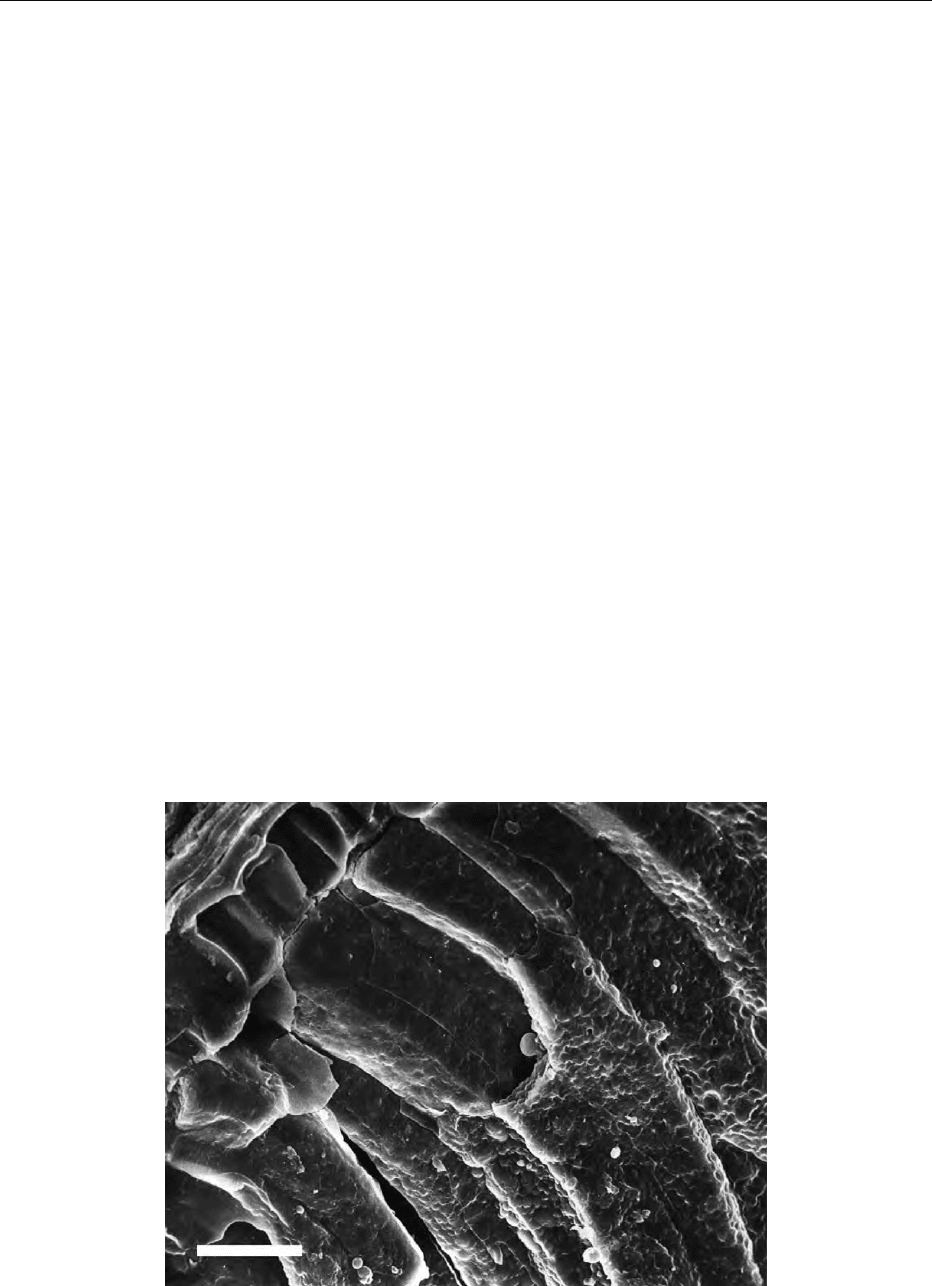
surrounding bran so that the maximum yield of
white flour is achieved with the minimum contamin-
ation of nonendosperm material. Fluted rollers are
used to break open the grain and scrape the endo-
sperm from the bran; smooth rollers are used to
reduce the endosperm particles into flour. The mois-
ture content of cleaned wheat is adjusted to between
15% and 17% prior to being fed to the fluter. This
process is called conditioning and its aim is to facili-
tate separation of bran and endosperm, and to
toughen the bran, thereby reducing the amount of
ash in the flour.
0019 Conditioning can be completed in approximately
6 h for soft wheat, but hard wheat may require 24 h or
longer. The X-ray method has shown that added
water moves rapidly through the bran layers, but
may remain at the aleurone–endosperm interface for
several hours. The rate of water penetration through
the endosperm is dependent on protein content, ini-
tial moisture, and grain hardness. The air spaces that
are present in the endosperm of the soft wheat allow
water to move more rapidly and hence conditioning
time is less than that required for hard wheat.
0020 Of morphological factors which can influence the
yield of clean, white flour, the shape of grain and
the amount of endosperm within the grain are par-
ticularly important. Grain size has been shown to be
significant; larger grains have a higher potential flour
yield. Image analysis has been used to measure a large
number of morphological parameters, and extraction
has been shown to correlate with grain length
parameters. However, the manner in which these par-
ameters influence extraction is not clear and further
work is required to determine their potential as a
screening system at wheat intake.
0021In addition to the amount of endosperm contained
in the grain, the efficiency with which bran and
endosperm can be separated (‘bran clean-up’) is also
a major factor influencing flour yield. Because of
intrinsic differences in the structure of hard and soft
wheat, they must be milled differently. The cell struc-
ture of soft wheat is very weak and readily broken. In
addition, the endosperm of soft wheat appears to
adhere more strongly to the bran. Durum wheat is
designed to produce semolina, a granular material
analogous to the farina or flour middling of the
hard-wheat-milling process. Granular products such
as semolina and farina are used for pasta, baby foods,
and other specialty foods.
0022Endosperm hardness influences the manner in
which grains fragment, and this can also influence
flour yield. Grain hardness is, in turn, influenced by
moisture and this is another objective of the condi-
tioning process. The efficiency with which floury
endosperm is removed from overlying bran and the
degree to which bran is powdered or otherwise dam-
aged are both influenced by the manner in which
grain fractures during milling. If fracturing occurs at
the boundary between the endosperm cell wall and
cell contents (Figure 4), the endosperm is efficiently
fig0004 Figure 4 Scanning electron micrograph of subaleurone region of a mealy kernel of spring wheat var. Jara. Note that fracture has
taken place at the interface between cell contents and endosperm cell wall. Bar, 50 mm.
WHEAT/Grain Structure of Wheat and Wheat-based Products 6143
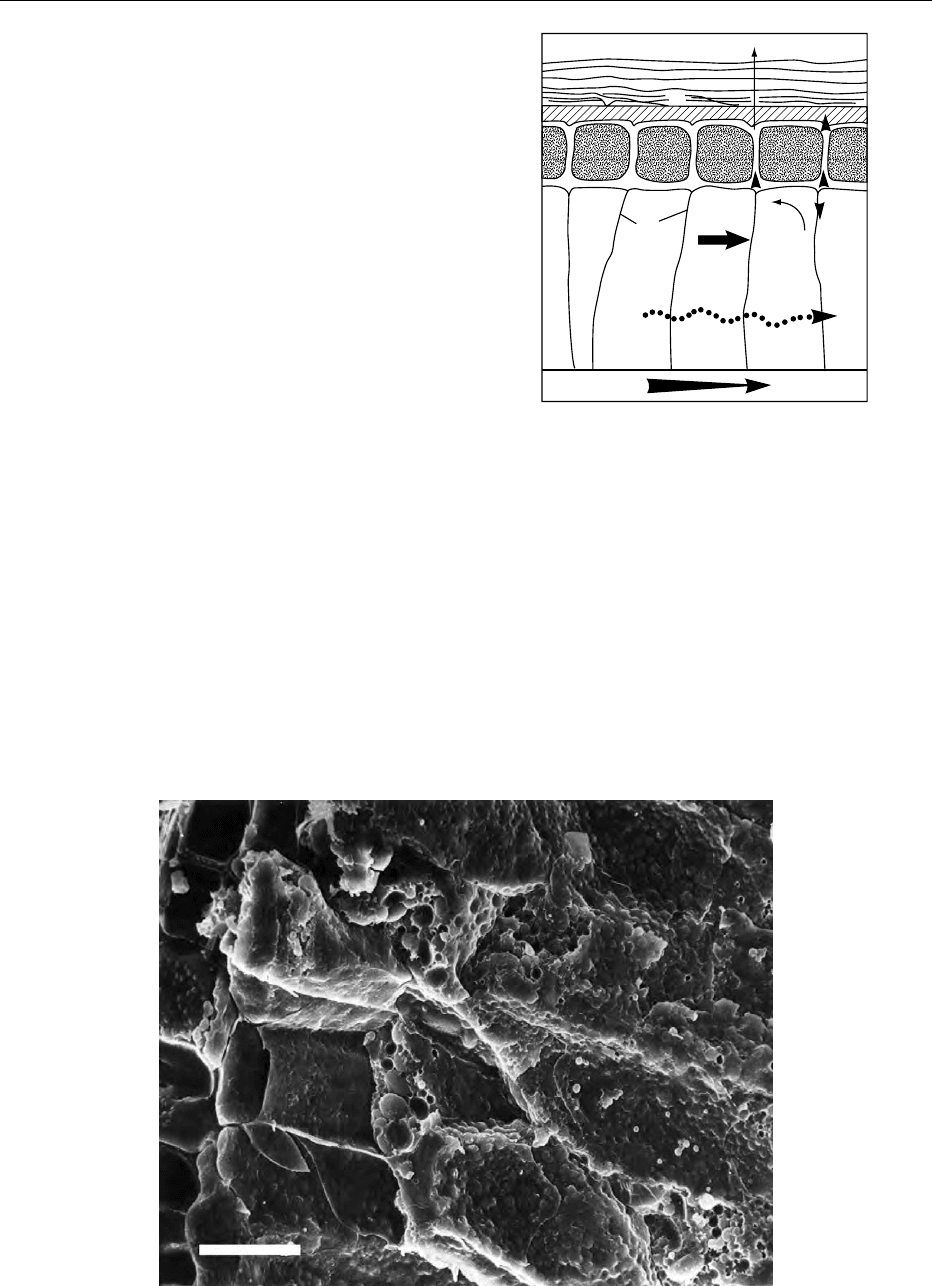
removed from the bran, but the bran is fractured into
small pieces.
0023 When the endosperm is fractured intracellularly
(Figure 5), bran clean-up is poor, but large pieces of
bran are produced. The manner in which the grain is
fractured is determined by both the inherent hardness
of wheat grain and its moisture content. It is thus
possible to optimize the relationship between grain
hardness, bran clean-up, and powdering by adjust-
ment of moisture level and conditioning time.
0024 Another difference between hard and soft wheat is
the point of the endosperm fragmentation. In hard
wheat it takes place mainly at the boundary between
adjacent cells as the contents of the cells are more
firmly bound together by a continuous matrix pro-
tein. Thus, hard wheat endosperm can be removed
more efficiently from bran as the shear forces
imparted by the fluted rollers are directed along the
boundary between adjacent endosperm cells towards
the bran (Figure 6).
0025 When they reach the bran, some of the forces are
deflected along the aleurone–endosperm interface,
facilitating separation of endosperm from bran. Of
course, as the kernel is reduced to flour size, the hard
wheat cell contents are also fractured. In soft wheat,
the discontinuities in the protein matrix allow endo-
sperm contents to break apart more easily and cleav-
age takes place intercellularly. Thus the shear forces
are dissipated within the endosperm and are not
redirected towards the bran.
B
W
E
A
fig0006Figure 6 Diagrammatic representation of the forces acting on
one endosperm cell of a wheat grain. Large arrow at the base of
the figure indicates the direction of the shear force caused by the
differential speed of the break rollers. In hard wheat the contents
of the cell behave as one unit and hence the cell is cleanly torn
from the overlying aleurone layer (indicated by the dashed line).
In soft wheat the shear force passes through the content of the
cell, as indicated by the dotted arrow. B, bran layer; A, aleurone
layer; W, endosperm cell wall; E, endosperm. Reproduced from
Wheat: Grain Structure of Wheat and Wheat-Based Products, En-
cyclopaedia of Food Science, Food Technology and Nutrition,
Macrae R, Robinson RK and Sadler MJ (eds), 1993, Academic
Press.
fig0005 Figure 5 Scanning electron micrograph of the subaleurone region of a mealy kernel of spring wheat var. Jara. Note that the fracture
is intercellular. Bar, 50 mm.
6144 WHEAT/Grain Structure of Wheat and Wheat-based Products
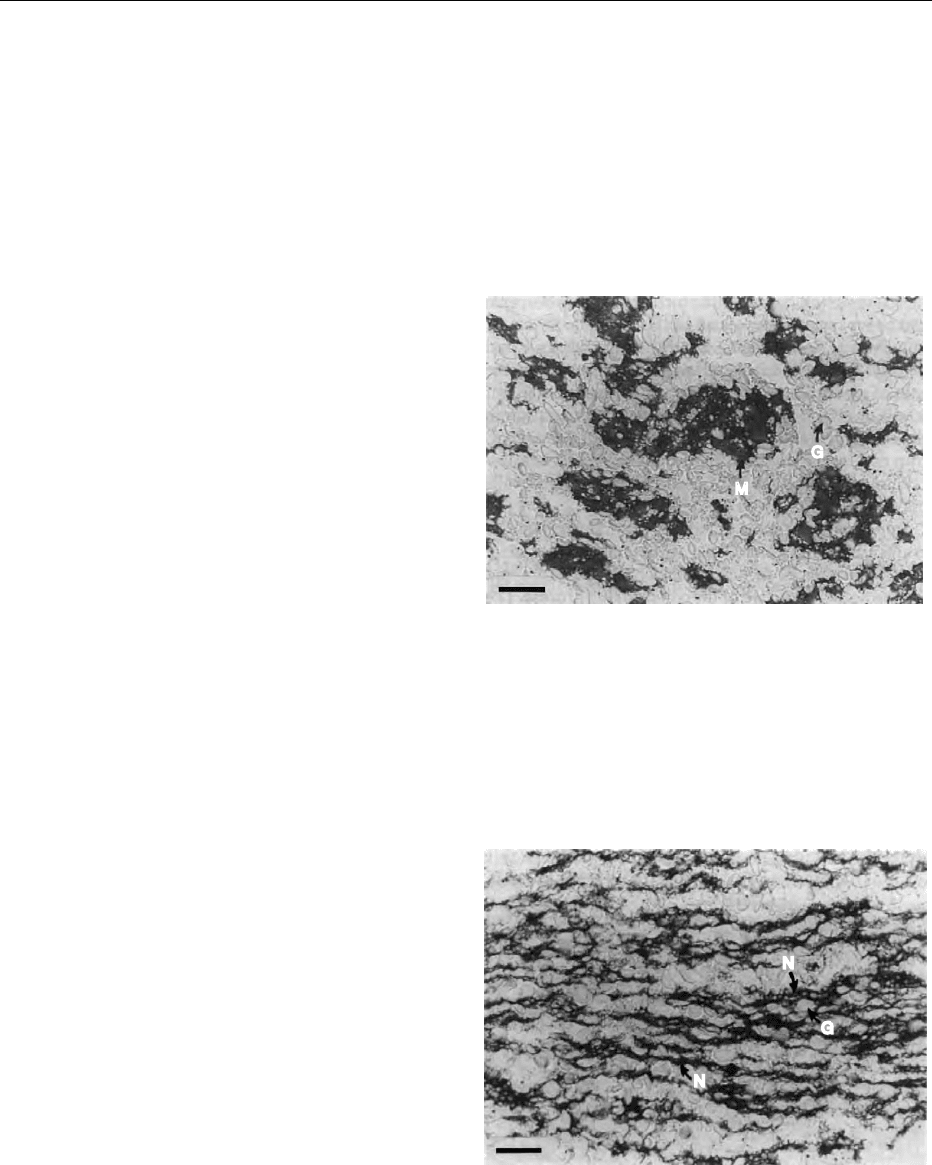
0026 Microscopy can also be used to study the mode of
action of different items of mill equipment and the
effect of processing variables on flour quality. Starch
damage is regulated by the amount of pressure ap-
plied by the smooth reduction rollers. The physically
damaged granules absorb more water and are more
susceptible to enzyme attack. A controlled level of
starch damage is required for bread flours. The higher
roller pressures produce thin flakes of endosperm and
microscopic examination has indicated that the ap-
pearance of the protein is altered. The protein has
been spread over the surface of the starch granules
and its functional properties are adversely affected so
that cohesive elastic gluten cannot be formed from the
protein in the flakes. The appearance of the starch
granules in flaked endosperm is usually similar to
that seen prior to flaking and the damage is only
apparent on hydration, when the granules absorb
water and rapidly swell. The amount and nature of
bran and wheat germ in stock or flour steams can be
determined using microscopy. Bran contamination is
important as it adversely influences flour color and
ash. Typical wheat has an ash content of about 1.5%.
However, the ash is not distributed evenly in the
grain. The inner endosperm may only contain 0.3%,
whereas the bran may contain 6%. Wheat germ has
less effect on flour color, but reduces gluten strength
and influences improved requirement in bread-
making.
Dough
0027 When water is added to flour and energy is imparted
to the dough by a mixer, the gliadin and glutenin
proteins interact to form elastic, cohesive gluten.
The mechanism and rate of gluten development
depend on the level of water addition and rate of
work input. In bread dough the level of water add-
ition (55–62%) is sufficient to cause the mixer ini-
tially to pull the gluten away from the starch granules
and form coarse, poorly connected masses (Figure 7).
As mixing proceeds, these masses are gradually
stretched out and become more interconnected and
eventually form a uniform, continuous, extensible
network, which surrounds the majority of the starch
granules in the dough (Figure 8).
0028 Such a gluten network gives dough a smooth exter-
nal appearance and prevents loss of carbon dioxide
produced by yeast during fermentation. This ultim-
ately results in a fine porous structure that is typical of
good-quality bread. If mixing is prolonged the protein
may become overdeveloped and flow over all starch
granules in a thin, veiling film. Carbon dioxide can
diffuse through the thin film and escape from the
dough, which ultimately results in a small, dense
loaf of bread. Overdevelopment only takes place if
rate of work input from the mixer is above the critical
level for that flour and dough system. If the rate of
work input is below the critical level, overdevelop-
ment does not occur and the protein matrix gradually
becomes more coarse and discontinuous. This phe-
nomenon has been termed ‘unmixing’. Much em-
phasis has been placed on the mixing process, but
M
G
fig0007Figure 7 Light micrograph of a cryostat section of an under-
developed bread dough. The stain was Ponceau 2R. Note the
coarse gluten masses (M) that do not surround the majority
of the starch granules (G). Bar, 60 mm. Reproduced from
Wheat: Grain Structure of Wheat and Wheat-Based Products, En-
cyclopaedia of Food Science, Food Technology and Nutrition,
Macrae R, Robinson RK and Sadler MJ (eds), 1993, Academic
Press.
N
N
G
fig0008Figure 8 Light micrograph of a cryostat section of an optimally
developed bread dough. The stain was Ponceau 2R. Note the
coarse gluten masses have become more interconnected and
form a continuous network (N) that surrounds the majority of the
starch granules (G). Bar, 60 mm. Reproduced from Wheat: Grain
Structure of Wheat and Wheat-Based Products, Encyclopaedia
of Food Science, Food Technology and Nutrition, Macrae R,
Robinson RK and Sadler MJ (eds), 1993, Academic Press.
WHEAT/Grain Structure of Wheat and Wheat-based Products 6145

the dough structure formed by mixing can be modi-
fied by the nature and timing of subsequent dough-
processing stages. Dough pieces are usually molded
into shape by passage through sheeting rollers. The
dough molder can further develop the gluten network
or unmix it. Which phenomenon occurs depends
on dough strength and the time between molding
and the previous processing stages. Generally, flour
from the hard wheat grains gives a more adequate
structure of dough for breads.
0029 In other types of dough the pattern of gluten devel-
opment is modified owing to lower levels of water
addition or the presence of other ingredients, particu-
larly high levels of fat. In flaky pastries or short, sweet
biscuits, a continuous gluten matrix is undesirable, as
it would give rise to a tough or hard end product.
0030 The level of water addition in noodle or pasta
dough is considerably less (30–33% addition) than
that in bread, and no protein pullback occurs during
mixing. The function of mixing in these processes is
to insure uniform distribution and hydration of ingre-
dients. The continuous gluten matrix is formed by
sheeting rollers in the case of noodles and by high-
pressure extrusion in the case of pasta.
Cooked Products
0031 One of the major changes that can take place during
the cooking of baked products is gelatinization of the
starch granules, and the extent to which this has
occurred is easily followed using polarized light mi-
croscopy. Starch gelatinization can also result in the
formation of more significant sample preparation ar-
tifacts than occur when samples containing ungelati-
nized starch are prepared using similar techniques. In
some products, the gelatinized starch granules absorb
a large amount of water, and freezing or dehydration
can give rise to artifacts. However, these can be min-
imized and appropriate allowance made when inter-
preting data. In expanded, extruded products the
gelatinized starch granules have a high capacity for
absorbing water and this gives rise to a high degree of
swelling if aqueous reagents are used during process-
ing for LM.
0032 For gelatinization to occur there must be an appro-
priate combination of heat and moisture and in many
baked products the latter can be insufficient. In bread,
only a narrow zone of starch granules in the crust still
shows some birefringence. However, in biscuits and
pastries that contain a high level of fat the majority of
the starch granules are frequently still birefringence
(i.e., not gelatinized). In some cooked cereal foods the
continuous phase, responsible for sample integrity, is
gelatinized starch (e.g., products made from batters
or from high-pressure cooker-extruders), whereas in
others (e.g., all breads, noodles, and pasta) it is
gluten. The nature of the continuous phase influences
raw material selection and the organoleptic proper-
ties of the end product.
0033Generally, flour from soft wheat grains gives a
structure of dough which is more adequate for
cooked products. Recent investigations have shown
that it is possible to identify the two molecular pro-
teins called puroindolines – pin A and pin B – which
correlate perfectly with wheat texture. This discovery
should help wheat breeders in the future to develop a
supersoft variety for making new kinds of cakes and
cookies.
See also: Microscopy: Light Microscopy and
Histochemical Methods; Scanning Electron Microscopy;
Transmission Electron Microscopy; Milling: Principles of
Milling; Types of Mill and Their Uses; Wheat: The Crop
Further Reading
American Association of Cereal Chemists (1990) Advances
in Cereal Science and Technology. St Paul, MN: Ameri-
can Association of Cereal Chemists.
Angold RE (1979) Cereals and bakery products. In:
Vaughan JG (ed.) Food Microscopy, pp. 75–
136.London: Academic Press.
Betchel DB (1990) Preparation of cereals and grain prod-
ucts for transmission electron microscopy. Food
Structure 9: 241–251.
Evers AD (1979) Cereal starches and proteins. In: Vaughan
JG (ed.) Food Microscopy, pp. 139–186. London:
Academic Press.
Fornal J, Jelin
´
ski T, Sadowska J and Quatrucci E (1999)
Comparison of endosperm microstructure of wheat and
durum wheat using digital image analysis. International
Agrophysics 13: 215–220.
Fulcher RG and Wong SI (1980) Inside cereals – a fluores-
cence microchemical view. In: Inglett GE and Munck L
(eds) Cereals for Food and Beverages, pp. 1–26. New
York: Academic Press.
Hoseney RC (ed.) (1990) Structure of cereals (I). In: Prin-
ciples of Cereal Sciences and Technology. St. Paul, Min-
nesota, USA: American Association of Cereal Chemists.
Niewczas J, Kudra T, Strumillo P and Wozniak W (2000)
Stress cracking as a measure of grain quality after ther-
mal drying. In: Mujumdar AS and Suvachittanont S (eds)
Development in Drying, vol. II, pp. 1–31. Bangkok,
Thailand: Kasertsart University Press.
O’Brien TP and McCully ME (1981) The Study of
Plant Structure. Principles and Selected Methods,
pp. 2.2–4.56. Melbourne: Termarcarphi.
Wozniak W, Grundas ST and Kocon J (1991) Qualitative
effect of moisture treatment of wheat grain by means
X-ray and SEM techniques. In: Kratochvil J (ed.)
Proceedings of the ICC Symposium, Prague, vol. 2,
pp. 494–499.
6146 WHEAT/Grain Structure of Wheat and Wheat-based Products

WHEY AND WHEY POWDERS
Contents
Production and Uses
Protein Concentrates and Fractions
Fermentation of Whey
Principles of Dialysis
Applications of Dialysis
Production and Uses
J G Zadow, Mount Martha, Victoria, Australia
Copyright 2003, Elsevier Science Ltd. All Rights Reserved.
Origins and Characteristics of Liquid
Whey
0001 For many years, whey, the byproduct of casein and
cheese manufacture, was treated as a waste product.
Most whey was disposed of by feeding to animals, or
running to waste in streams or on to the land. The
comparatively small amount that was used was
mainly directed at the animal-feed market. In the
past few decades, however, environmental pressures,
coupled with a recognition of the inherent value of
whey solids, have resulted in the development of pro-
cesses for the conversion of liquid whey into a range
of valuable food ingredients. Today, whey and whey
products are in considerable demand, both as replace-
ment ingredients for more expensive existing prod-
ucts and, more often, as functional and nutritional
ingredients in their own right. The use of whey prod-
ucts in the animal feed market is still very important,
but in many major markets, such as the USA, domes-
tic utilization of whey powder for human foods is
greater than that for animal feed. In Europe, however,
animal feed still remains the dominant use for whey
powder. This section reviews the source of wheys,
compositional factors affecting utilization, alterna-
tives for processing of whey properties of whey
powders, and their uses in the food industry.
0002 Little information is available on worldwide pro-
duction of whey. In 1987, it was reported that the
annual world production was about 110 million
tonnes, of which about 47 million tonnes were pro-
duced in Western Europe, 27 million tonnes in North
America, 30 million tonnes in Eastern Europe, and 8
million tonnes elsewhere; Australia produces about
1.8 million tonnes. Given the considerable increase in
cheese production worldwide since 1987, it is prob-
able that the current world production of whey is up
to 50% higher than the figure quoted above.
0003Therefore, two pressures exist on whey processors
to increase whey utilization. First, there is the rapid
increase in the total volume of whey produced, owing
to increasing cheese manufacture, and second, there is
much greater pressure from environmental regulatory
bodies to reduce disposal, and increase utilization of
whey. A detailed survey of whey utilization and dis-
posal practices was carried out in Australia in the
early 1990s, and many of the conclusions are prob-
ably applicable to other major whey-producing coun-
tries. In Australia, about 50% of the total whey
produced is used (an increase from 46% utilization
in the mid-1980s), with the remainder being disposed
mostly on to land. However, in spite of the consider-
able increase in whey production over the past
decade, the percentage of whey used is believed to
have remained approximately constant. In the 1980s
in Australia, membrane processing was a popular
means of whey utilization, representing about 25%
of the whey used. By the early 1990s, this level had
decreased to about 10% and is currently believed to
have fallen even lower. By far the greatest means of
whey utilization now is via whey powder manufac-
ture (of interest is the fact that, although membrane
processing represented only a comparatively small
amount of the whey processed, all of the permeate
produced was used).
0004It should be noted that the greatest disposal prob-
lems were encountered by factories that produced
only moderate amounts of whey. The major options
for disposal of whey, either through drying or through
membrane processing and permeate utilization, were
often too capital-intensive and scale-sensitive to be an
option for such companies. The development of
economic whey utilization techniques for such manu-
facturers would be of considerable benefit to the
industry.
Source and Composition of Wheys
0005Whey is the watery substance remaining after coagu-
lation of the casein in milk, either through the
WHEY AND WHEY POWDERS/Production and Uses 6147

addition of acid (as in casein manufacture) or through
the action of a protease such as chymosin (as in cheese
manufacture). Clearly, the composition of whey
varies considerably, depending on the source of the
milk and the manufacturing process involved. How-
ever, on average, whey contains about 65 g of solids
per kilogram, comprising about 50 g of lactose, 6 g of
protein, 6 g of ash, 2 g of nonprotein nitrogen, and
0.5 g of fat. Casein whey generally has a significantly
higher level of ash than cheese wheys.
0006 It is convenient to classify whey into three major
types:
1.
0007 Sweet wheys: titratable acidity 0.10–0.2%, pH
typically 5.8–6.6. This category would include
wheys produced from chymosin-coagulated
cheeses with a low level of acidity.
2.
0008 Medium acid wheys: titratable acidity 0.20–
0.40%; pH, typically 5.0–5.8. This class could
include whey from the manufacture of fresh acid
cheese such as ricotta or cottage cheeses.
3.
0009 Acid wheys: titratable acidity greater than 0.40%,
pH less than 5.0. This class would include casein
wheys made by addition of mineral acids, and
some fresh acid cheese wheys.
A detailed composition of dried sweet and acid wheys
is shown in Table 1.
0010The following points are of particular relevance in
assessing options available for the processing of whey
streams:
1.
0011Whey has a total solids of about 6.5%, i.e., it is a
fairly dilute product. Thus, to produce 1 kg of
whey powder requires the removal of about
twice as much water as does the production of
1 kg of milk powder. Removal of water is a costly
unit operation, and this factor alone mitigates
against many options for whey processing.
2.
0012Of the total solids in whey, more than 75% is
lactose. The effective utilization of whey is there-
fore inextricably linked with the effective utiliza-
tion of lactose. Unfortunately, lactose is not a
commercially valuable sugar, as it is not particu-
larly soluble, and it is not particularly sweet
(Table 2). These factors limit the commercial
applications of whey solids considerably.
3.
0013The proteins present in whey comprise about 50%
b-lactoglobulin, 25% a-lactalbumin, and 25%
other proteins. Whey proteins have a very high
nutritional profile, are rich in essential amino
acids, and can have excellent functional pro-
perties. Clearly, the whey proteins are the most
valuable components of whey, and most whey-
processing operations (e.g., ultrafiltration, manu-
facture of lactalbumin) therefore aim to increase
tbl0001 Table 1 Typical composition (%) of sweet and acid whey powders, and whey protein concentrates
Moisture Crude protein True protein Lactose Fat Ash
Sweet whey
a
3.2 12.9 74.4 1.1 8.4
Acid whey
a
3.5 11.7 73.4 0.5 10.8
35% WPC
b
4.6 36.2 29.7 46.5 2.1 7.8
50% WPC
b
4.3 52.1 40.9 30.9 3.7 6.4
65% WPC
b
4.2 63.0 59.4 21.1 5.6 3.9
80% WPC
b
4.0 81.0 75.0 3.5 7.2 3.1
a
Data from Posati LP and Orr ML (1976) Agriculture Handbook, No. 8^1. Washington, DC: US Department of Agriculture.
b
Data from Glover FA (1985) Ultrafiltration and Reverse Osmosis for the Dairy Industry. Technical Bulletin, No. 5. Reading, UK: National Institute for Research In
Dairying.
tbl0002 Table 2 Relative sweetness and solubility of lactose, sucrose, and some monosaccharides
Sugar Relative sweetness
a
Solubility (g per100 g of solution)
b
10
C 30
C 50
C
Sucrose 100 66 69 73
Lactose 16 13 20 30
D-Galactose 32 28 36 47
D-Glucose 74 40 54 70
D-Fructose 173 82 87
a
Data from Pazur JH (1970) Oligosaccharides. In: Pigman W, Horton D and Herp A (eds.) The Carbohydrates: Chemistry and Biochemistry, p. 69. New York:
Academic Press.
b
Data from Shah NO and Nickerson TA (1978) Functional properties of hydrolyzed lactose: solubility, viscosity and humectant properties. Journal of Food
Science 43: 1081.
6148 WHEY AND WHEY POWDERS/Production and Uses
